Astronomers have found two stars on their way to exit the Milky Way moving at more than 1.6 million kilometers per hour. Last year three more such escapees were found. The study of such stars is important to unravel the so-far elusive problem of how the galaxies spin.
According to theory, a galaxy should rotate faster at the center than at the edges. This is similar to how an ice-skater rotates: when she extends her arms she moves more slowly, when she either extends her arms above her head or keeps them close to the body she starts to rotate more rapidly. Taking into consideration how gravitation connects the stars in the galaxy the predicted result is that average orbital speed of a star at a specified distance away from the center would decrease inversely with the square root of the radius of the orbit (the dashed line, A, in figure below). However observations show that the galaxy rotates as if it is a solid disk - as if stars are much more strongly connected to each other (the solid line, B, in the figure below).
In the attempt to explain this anomaly three propositions have been made: - One is the dark matter assumption: it is assumed there are numerous unseen particles (the dark matter) which can account for the motion of the galaxy - i.e. the galaxy really is more like a "solid" disk made out of dark matter and stars than only like a bunch of stars flying around almost freely and influencing each other via gravity. - Another assumption is made by the plasma physicists who claim that astronomers simply forget about electromagnetism: the galaxy is not stars and empty space, it is stars and plasma of electrons, protons and ions (sometimes referred to as "gases and dust") and thus, there are large scale electromagnetic forces that can easily account for the rotation of the galaxy. - Yet another assumption ignores the plasma physicists explanation and rejects the idea of unseen dark matter and supposes that the law of gravitation itself is wrong at large distances (such as the size of the galaxy): they have replaced the traditional law of gravity with another one which explains both the usual gravitational effect as well as the large scale rotation of galaxies.
The discovery of escaping stars from galaxy is crucial for understanding better the forces at work.
It is thought that the stars can reach such enormous speeds in the following way: They were part of a binary system - they had another companion star - and they had approached the black hole at the center of the galaxy. The black hole swallowed their companion and ejected the star with a slingshot.
The newly discovered stars are 180,000 and 240,000 light years from Earth, respectively, and about 45? above the galactic disc. "That puts them well away from and above the disc of the galaxy," said Warren Brown of the Harvard-Smithsonian Center for Astrophysics for the New Scientist Magazine. "They've already left the main part of the Milky Way." In order to find such escaping stars the team looked "for young, massive stars that have relatively short lifetimes and so shouldn't be in the outskirts of the Milky Way, where the stars are all quite old."
The team chose several hundred stars that appeared blue - and therefore young - in data from the ongoing Sloan Digital Sky Survey. In December 2005, they began studying some of the candidates using the 6.5-metre MMT telescope in Arizona, US. After just three nights of observing - covering 5% of the sky - they found the two "hypervelocity" stars. "We imagine finishing the entire list of candidates by the end of 2006," says Warren. "Then we should know how common these stars are."
According to various theoretical predictions, among the more than 100 billion stars in our galaxy, there may be only 1000 such escapees stars.
How does this discovery help resolving the galaxy rotation problem?
"If we're right and they [the stars] are shot out of the galactic centre by its supermassive black hole, they should be traveling in a straight line to where they are now," Brown says. "Any deviation from that straight line would measure how the gravity of the galaxy affects the trajectory of the star."
Ground-based telescopes are not sensitive enough to observe the stars' seemingly slight movement across the sky. But space-based telescopes, such as Hubble, should be able to detect it over a period of several years. Brown is submitting a proposal for Hubble to track the stars, but adds that it is not clear whether the 16-year-old telescope will be functioning long enough to do the study. NASA is considering sending a space shuttle to service the telescope, but the space shuttles are currently grounded until engineers can prevent them from shedding insulating foam on take off.

 14 DAY TRIAL //
14 DAY TRIAL // 
